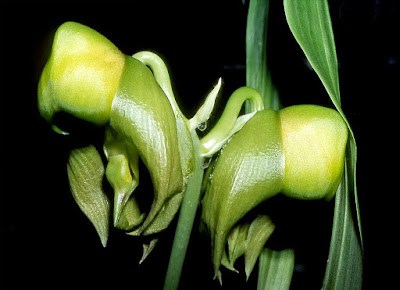Catasetum integerrimum is native to Mexico, through Central America, to Nicaragua. These plants are found in areas located both from the Pacific and Caribbean, as epiphytes growing in humid forests, on coffee plantations or in the open...
Catasetum integerrimum also called as The Intact Catasetum, Catasetum integrinum, Catasetum integerrimum var flavescens, Catasetum integerrimum var. luteo-purpureum, Catasetum integerrimum var. purpurascens, Catasetum integerrimum var. viridiflorum, Catasetum maculatum, Catasetum wailesii, is a species of the genus Catasetum. This species was described by William Jackson Hooker in 1840.
IDENTIFY CATASETUM INTEGERRIMUM
Catasetum integerrimum is native to Mexico, through Central America, to Nicaragua. These plants are found in areas located both from the Pacific and Caribbean, as epiphytes growing in humid forests, on coffee plantations or in the open. These plants occur at altitudes from the sea level up to 1800 m, but mostly in tropical forests at low altitudes.
It is a medium sized, hot to cool growing epiphyte, which reaching up to 50 cm in height, with ovoid to fusiform, 8-15 cm long and about 5 cm in diameter pseudobulbs carrying 6 to 8, oblong-lanceolate, plicate, deciduous, up to 65 cm long and 12 cm wide leaves.
The Intact Catasetum blooms in the late spring till fall on an arching to suberect, 25 cm long, racemose inflorescence with bracts arising on a mature pseudobulb. The flowers are not inverted (the lip is directed upwards) and are usually yellowish-green, and the fleshy green lipids often have red spots. They can also have a shade of purple with darker patches or larger surfaces so colored. Each flower is embedded in a stalk and ovary combination with a length of approx. 3 cm.
CATASETUM INTEGERRIMUM CARE AND CULTURE
Cultural information should only be used as a guide, and should be to be adapted to suit you. Your physical location; where you grow your plants, how much time you have to devote to their care, and many other factors, will need to be taken into account. Only then can you decide on the cultural methods that best suit you and your plants.
Light:
Catasetum integerrimum needs a light level of 25000-40000 lux. The light should be bright but filtered or dispersed. The plants in nature are sometimes exposed to direct sunlight, but in cultivation they will feel better if we protect them from the midday sun. Strong air movement should be ensured all the time.
Temperature:
It is a thermophilic plant. Throughout the year, the average day temperature is 27-29 ° C, and the average night temperature is 18-19 ° C, with a daily amplitude of 8-10 ° C. In winter, the average day temperature is 25-27 ° C, at night 15-16 ° C, with a daily amplitude of 9-11 ° C.
Humidity:
The Intact Catasetum needs the humidity of about 75-80% for most of the year, at the end of winter and early spring, falling to about 60-65%.
Substrate, growing media and repotting:
Catasetum integerrimum grow well mounted on pieces of tree ferns if only during the summer they will be irrigated at least once a day. In the case of such suspended plants, during the dry and hot periods it may be necessary to water several times a day.
They can also grow in pots with a substrate that quickly draining excess water, which, however, contains substances that retain a certain amount - such as chopped sphagnum moss or perlite. Wood charcoal is also often added to ensure the air permeability of the substrate and protection against acidification. As an addition to the basic substrate used in pots, i.e. pine bark, you can use Osmund fern fiber, tree ferns, sphagnum moss, volcanic pebbles, cork shards, and even a mixture of equal parts of recomposed and fresh horse manure and charcoal.
These plants do not tolerate acidification within the roots, which is why the annual repotting is recommend regardless of the substrate used. Repotting is carried out when a new growth appears at the base of the pseudobulb. All pseudobulbs should be separated, you leave only 1-2 pseudobulbs in the pot. Because old roots die after repotting, most of them can be cut off. A few can be left to facilitate plant fixing in new substrate until new roots develop. After repotting, no plants are watered until the new growth will release the roots into a new substrate and its height will reach 10-12 cm.
Watering:
In the period from late spring to autumn rainfall is moderate to heavy. Then, in the winter season of drought, their number drops quite rapidly. During active growth, the cultivated plants should be watered abundantly, while in autumn, when new growths reach maturity, the amount of water should be drastically reduced.
Fertilizer:
During the active growth, the plants should be fertilized every week 1/4-1/2 of the recommended dose of fertilizer for orchids. A fertilizer with a high nitrogen content is beneficial from spring to mid-summer, and a phosphorus-rich fertilizer can be used in late summer and autumn.
Rest period:
In the autumn, after the leaves have fallen, the Catasetum integerrimum plants should remain dry; the amount of water supplied should be such as not to allow the pseudobulbs to wrinkle. More of these plants die of excess water in winter than for any other reason. During the rest period fertilization should be eliminated. Normal watering and fertilization should be resumed when new increments begin to appear and new roots are 2-4 cm long.















COMMENTS